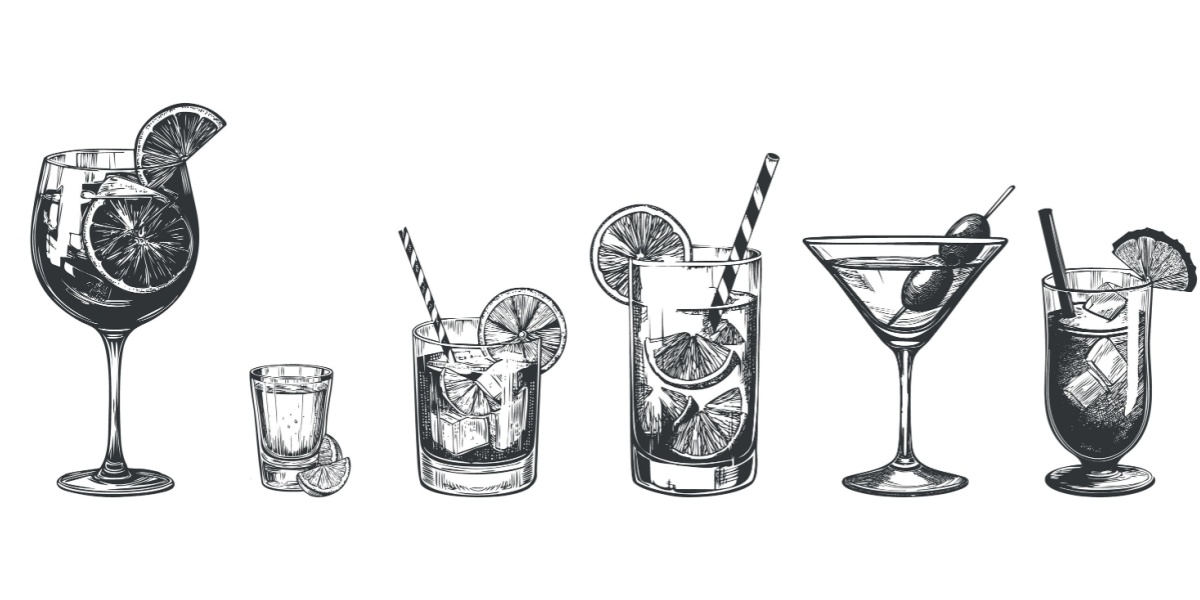We all know that there are many kinds of alcoholic drinks and that they come in a variety of flavors, colors, and strengths. Some alcohols are more dangerous to health, depending on whether they have been distilled or not.
- The three types of alcohol are methanol, isopropyl, and ethanol, which we use to make alcoholic drinks.
- Alcoholic drinks are normally split into two categories; distilled and undistilled.
- Undistilled alcohols include beers, wines, and ciders; distilled drinks are liquors and spirits like gin, whisky, and rum.

Different types of alcohol
Some of the earliest reported mentions of alcohol production date back as far as 4,000 B.C. Alcohol production occurs when a pair of oxygen and hydrogen atoms (a hydroxyl group) replace the hydrogen atom in hydrocarbons. These then bind with other atoms to create secondary alcohols, which are used to create the three types of alcohol we use today. These three types of alcohol are methanol, isopropyl, and ethanol, which we use to make alcoholic drinks.
Which of the three types of alcohol are safe to drink?
Methanol and isopropyl alcohols are poisonous to humans as our bodies metabolize them as toxins, which causes liver damage, making them unsafe for human consumption. These two types of alcohol are typically used for cleaning and manufacturing.
Isopropyl is the scientific term for rubbing alcohol which is used to clean and disinfect. It can be found in kitchen sprays, hand sanitizers, and medical disinfectants. Methanol is a component in fuel as well as antifreeze, windshield cleaner, and a range of other alcohol-based products. Drinking even a tiny amount of these types of alcohol can be fatal.
Ethanol is the only type of alcohol that can be consumed safely by humans. This alcohol is produced as part of the chemical byproduct of the fermentation process from yeast, sugars, and starches and comes in distilled and undistilled forms. While it can be safe to drink ethanol drinks, the body still metabolizes them as toxins, and they can be harmful when consumed in large doses.
Over-consuming ethanol can lead to the liver, brain, and other organs being damaged as well as acting as a central nervous system depressant, impairing coordination and judgment. The latter makes drinking alcohol dangerous when performing day-to-day tasks such as driving.
There is also the possibility of alcohol poisoning, the common expression for an alcohol overdose, which can be fatal. Abusing alcohol can also lead to physical dependence on the substance and if left unchecked can lead to devastating alcohol addiction.
Distilled vs undistilled drinks
Undistilled alcoholic drinks are those which have had little or nothing done to them past the fermentation process. During the fermentation process, bacteria or yeast chemically convert sugar and starches into ethanol. Wine and beer are the oldest forms of undistilled alcoholic drinks, with wine being made from fermented grapes and beer from barley, wheat, and other types of grain.
Distilled alcoholic drinks go through a further process after the fermentation stage. The distillation process concentrates the alcohol content of fermented drinks by removing water and other components, making them stronger. All forms of liquor and spirits are distilled alcohol and typically have higher alcohol by volume (ABV) and alcohol proof than undistilled alcohols.
ABV and proof are two separate measures that indicate the alcohol content or concentration of beverages. ABV is the number of milliliters of ethanol per 100 milliliters of liquid (3.4 fl.oz.) and proof is twice the alcohol by volume percentage (e.g. 45% ABV will be 90 proof).
Types of undistilled drinks
Wine and beer are the main types of undistilled drinks and have been made and consumed around the world for thousands of years. They more often than not have a lower ABV and proof than distilled drinks, meaning it normally takes a higher volume to become intoxicated. While the lower ABV may indicate that undistilled alcohols are safer to drink, they can still cause alcohol poisoning and other health risks and are just as likely to lead to addiction as distilled drinks.
Beer
After water and tea, beer is the most commonly consumed drink in the world and likely the oldest recorded in history. Most beers come as either a lager or ale with an average ABV of between 4 and 6%. Some beers do come with lower or higher ABV, with light beers usually having between 2 and 4% and malt liqueurs and strong lagers having up to 12%.
Wine
Wine is another drink that dates back centuries and has many varieties from all over the world. The most common forms of wine come in red, white, and rose varieties with a standard ABV of between 12 and 14%. Champagne, prosecco, cava, and other sparkling wines are carbonated for a fizzy finish and are normally between 10 and 12% ABV. Fortified wines such as vermouth, port, and Madeira are mixed with distilled alcohol to give a higher ABV, normally around 20%.
Saké
Sake uses fermented rice and originates from Japan. It typically has a higher ABV than other undistilled alcohols at around 16-18%.
Cider
Cider or hard cider is made with the same process as beer but uses fermented apple juice. The standard ABV of cider is around 5% but there are light and strong options also.
Mead
Mead can be dated back to the ancient Egyptians and consists of water and fermented honey with an ABV of between 10% to 14%.
Types of distilled drinks
Gin
Gin is made with a combination of juniper berries and other botanical elements. Its ABV ranges from 35 to 60%.
Brandy
Brandy is a form of distilled wine that is stronger than other fortified wines. The most famous type of brandy is Cognac that has an ABV of 40% with other types of brandy ranging from 35 to 60%.
Whisky
Whisky is made with fermented grain and has its origins in Scotland, though is now produced in different varieties all over the world. The typical ABV for whisky is 40 to 55%
Rum
Rum is made by distilling fermented sugarcane or molasses and comes in dark, white, and spiced versions. Typically, rum has an ABV of 40% though some overproofed versions can be 57.5 to 75.5%.
Tequila
Tequila originates from Mexico and is made from fermented agave, a type of cactus. Tequila ABV is normally around 40% but can go up to 60%. The drink usually comes in clear or golden colors, but can be combined with other ingredients to create new flavors.
Vodka
Vodka has its origins in Russia and other Eastern European countries, typically made by distilling fermented grains and potatoes with a clear finish. Standard vodka concentration is 40% but like tequila, some can reach 60%.
Absinthe
Absinthe is a spirit that was banned for many years due to its supposed hallucinogenic properties. It is made from fermented herbs and leaves and normally has a vivid green color, leading to the nickname “the green fairy”. It is now commonly sold with a 40% ABV though some manufacturers still produce 90% varieties.
Everclear
Everclear is a grain-based spirit and has one of the highest ABV levels of any alcoholic drink, typically around 60% but reaching as high as 95%. These are sometimes referred to as ETOH alcohol drinks.
Other products that contain alcohol
While traditional distilled and undistilled alcohol is still the most widely consumed form of the substance, there are a range of products that contain alcohol. Some of these have raised concerns due to their marketability to children and their low regulations. Some of the most common alcohol-containing products include:
Alcohol energy drinks - Alcoholic energy drinks have been around for over a decade, though stronger regulations have led to the drinks being banned or having to be rebranded. The most notable case was Four Loko, which, despite its 12% ABV, was marketed as an energy drink until it was banned in 2010 and reintroduced as a purely alcoholic beverage.
Kombucha - typical Kombucha is less than 0.5% ABV meaning it can be marketed as an alcohol-free beverage to under 21s. However, there are versions of the drink that have a higher alcohol by volume level and are thus only for sale to those over 21.
Alcohol powder - Also known as dry alcohol or crystalline alcohol, powdered alcohol is created by a complex chemical process known as microencapsulation, which uses sugars to absorb alcohol. The powder is mixed with liquid to make it alcoholic, which has caused concerns with regulators due to the inability to control ABV levels when used.
Hard seltzers - Hard seltzers such as White Claw have risen in popularity in the last few years as a lower-alcohol alternative to other beverages. This has made them popular amongst teens and young people as the popular opinion is they do not get you drunk, though this is not the case at all.
Drink responsibly
Alcohol tolerance, dependence, and addiction can form quickly, changing the brain’s chemical balance until the alcohol is required to function or feel normal. The risk of dependence and addiction is increased when people drink irresponsibly, such as with binge drinking. Also, due to alcohol’s wide social acceptance, many don’t know they are developing a problem.
If you are worried about your drinking or are concerned about a loved one, these tips can help reduce alcohol intake and control the impulse to drink.
- Consider alternatives to alcohol or going to places that serve alcohol
- Pace alcohol; have a glass of water between drinks and give yourself a limit
- Eat well and don’t consume alcohol on an empty stomach
- Don’t drink on consecutive days; the “hair of the dog” is not a cure for a hangover
- Drink low alcohol alternatives
- Adding mixers to spirits does not always mean less alcohol, as most people are able to consume liquor in higher volumes when mixed with tonic or soda
- Avoid drinking games or situations where large volumes of alcohol are consumed in a short period
If you are unable to do any of the above, or if drinking has overpowered your life, then speak to a treatment provider or addiction specialist today. Help is always available and recovery from an alcohol use disorder is possible.


-guide-detail.jpg?v=1722503065)
